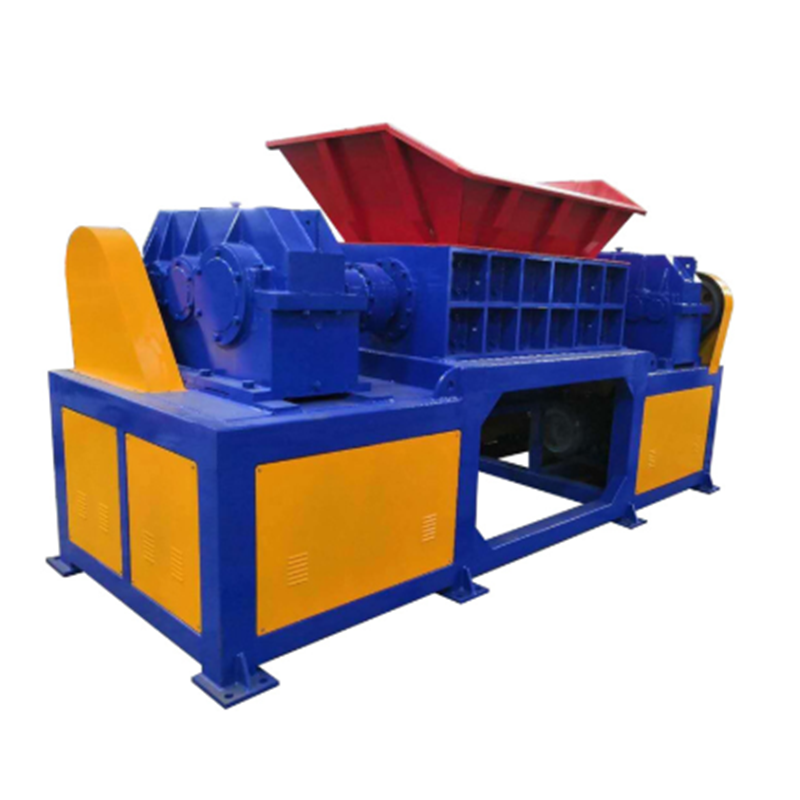How to recycle and reuse waste clothes using a double roller shredder?
Date:2024-08-27
View: Point
Recycling and reusing waste clothes using a double roller shredder involves a multi-step process that begins with sorting the textiles and ends with the creation of new products. Here’s a step-by-step guide on how to recycle and reuse waste clothes with a double roller shredder:
1. Collection and Sorting
- Collection: Gather waste clothes from various sources such as households, thrift stores, donation bins, and commercial outlets.
- Sorting: Sort the clothes into categories based on fabric type (cotton, polyester, wool, etc.), color, condition, and intended use. Sorting helps ensure that the shredded material is suitable for specific recycling processes.
2. Pre-Processing
- Cleaning: Remove any non-textile materials such as buttons, zippers, and metal tags. Cleaning the clothes can involve washing to remove dirt and other contaminants.
- Cutting: Large garments might need to be pre-cut into smaller pieces to fit into the shredder.
3. Shredding with a Double Roller Shredder
- Loading: Feed the pre-processed clothes into the hopper of the double roller shredder.
- Shredding: The double roller shredder consists of two rollers equipped with teeth or knives that rotate towards each other, tearing the clothes into smaller pieces. The rollers' configuration allows for a controlled reduction of the material.
- Screening: The shredded material passes through a screen or grate to ensure uniform size. The size of the shredded output can be adjusted by changing the screen size.
4. Post-Shredding Processing
- Decontamination: If necessary, the shredded material may undergo additional cleaning processes to remove any remaining impurities.
- Sorting by Material: Further sorting of the shredded material can be done to separate different fiber types, especially when dealing with blended fabrics.
5. Fiber Recovery and Reuse
- Carding and Combing: For textile fibers, carding and combing processes can align the fibers and remove short fibers and impurities.
- Spinning: Carded or combed fibers can be spun into yarn for use in new textile products.
6. Reuse and Repurposing
- Textile Production: The recycled yarn can be used to manufacture new textiles or clothing items.
- Non-Woven Materials: The shredded material can be used to create non-woven fabrics for applications such as insulation, soundproofing, or automotive interiors.
- Composite Materials: Fibers can be combined with other materials to create composite products, such as reinforced plastics used in construction or automotive parts.
- Filling Material: Shredded textiles can serve as filling material for pillows, stuffed toys, or mattress padding.
- Industrial Wipes: The shredded material can be used for cleaning rags or industrial wipes.
- Landscaping and Gardening: Textile fibers can be used as mulch or soil reinforcement in landscaping and gardening applications.
7. Quality Control and Testing
- Testing: Ensure that the recycled material meets quality standards for its intended use. This includes testing for strength, durability, and compliance with any relevant regulations.
8. Marketing and Distribution
- Product Development: Develop new products using the recycled material.
- Marketing: Promote the recycled products as eco-friendly alternatives to traditional materials.
- Distribution: Distribute the products through retail channels or directly to manufacturers who can use the recycled materials in their production processes.
Considerations:
- Efficiency: The efficiency of the shredding process depends on the quality of the shredder and the preparation of the materials.
- Economics: The cost-effectiveness of recycling textiles can vary depending on factors such as labor costs, energy usage, and market demand for recycled products.
Environmental Impact: Recycling textiles reduces waste and the environmental footprint associated with the production of new textiles.

Using a double roller shredder to recycle waste clothes can be a sustainable and efficient way to manage textile waste while creating valuable resources. If you need more detailed information or specific recommendations based on your needs, feel free to ask!
Zhongcheng Machinery Will Be There Whenever Wherever Whatever You Need
You Are Welcome to : phone call, Message, Wechat, Email& Seaching us, etc.
Email:
sales@zchmachinery.com
Whatsapp/Phone:
+8618738194110
hot Products
-
 Trommel screenTrommel screen, also known as drum screens, are widely used in various industries for sorting and separating materials.Get Quote
Trommel screenTrommel screen, also known as drum screens, are widely used in various industries for sorting and separating materials.Get Quote -
 Crop straw double shaft shreddApplications:Biomass Energy Production: Shredded straw can be used as a feedstock for bioenergy plants to produce electricity or heat.Livestock Feed: Reduced-si...Get Quote
Crop straw double shaft shreddApplications:Biomass Energy Production: Shredded straw can be used as a feedstock for bioenergy plants to produce electricity or heat.Livestock Feed: Reduced-si...Get Quote -
 Zhongcheng Air Drum SeparatorAir drum separators effectively separate lightweight materials (e.g., plastics, paper) from heavier materials (e.g., metals, glass). This high efficiency is cru...Get Quote
Zhongcheng Air Drum SeparatorAir drum separators effectively separate lightweight materials (e.g., plastics, paper) from heavier materials (e.g., metals, glass). This high efficiency is cru...Get Quote
relate news
-
2023-01-12Waste FeederWaste feeder was specially designed to optimize municipal solid waste sorting systems. The Drum Feeder ensures that your sorting system, baler or shredder has a...
-
2024-08-07Tire double shaft shredderOperation:Feeding: Whole or pre-cut tires are fed into the shredder through an inlet hopper.Shredding: As the tires enter the shredding chamber, the rotating cu...
-
2024-07-16Drum screen garbage processing machine for msw recyclingManaging municipal solid waste (MSW) efficiently is crucial for urban areas. Drum screen garbage processing machines are a game-changer in this field. They ensu...
-
2024-05-18C Series Jaw CrusherC series jaw crusher is a jaw crusher with excellent performance introduced and developed by zchmachinery according to the market demand. Compared with traditio...
-
2024-07-16Twin-shaft shredders: ideal for efficient processing of waste and recycling materialsA double-shaft shredder is a mechanical device used to process waste and recycle materials. Its main feature is that it has two rotating shafts with serrated bl...



